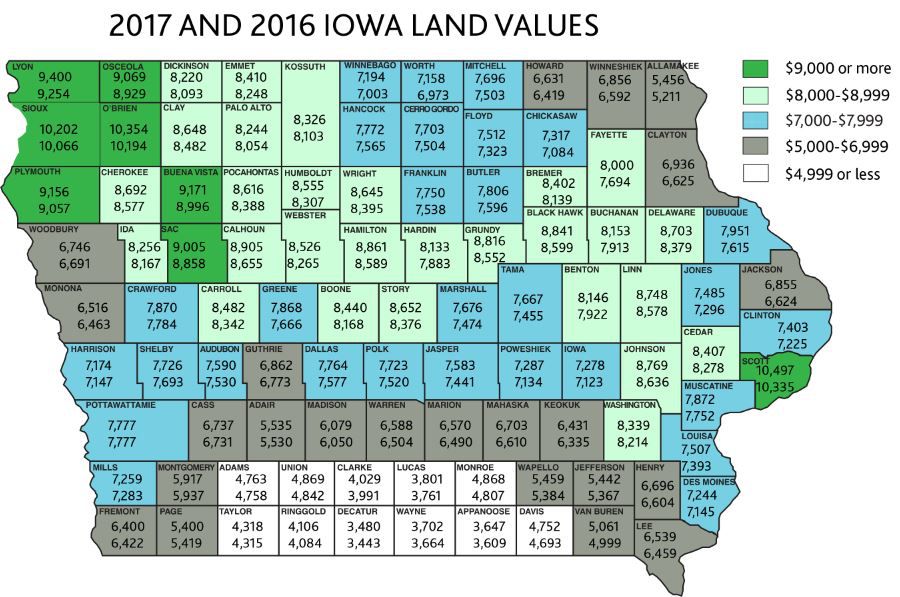Iowa farmland values climb slightly in 2017, ISU survey shows
Author
Published
12/18/2017
The Iowa farmland market is leveling out but likely hasn’t found its bottom yet, Iowa State University (ISU) economist Wendong Zhang said last week.
Iowa farmland values rose 2 percent in the past year, marking the first increase since land values fell off their peak in 2013, according to the annual ISU farmland value survey.
“I would not consider this a turn of the land market,” said Zhang, an assistant professor of economics at ISU who coordinates the survey. “This, to me, is a temporary break in a downward adjustment trajectory. Given the rising interest rates and stagnant farm income, I would not be surprised to see a continued decline in values in the future.”
The average value of an acre of farmland in Iowa is now estimated at $7,326, an increase of $143 per acre from the 2016 estimate.
But increases weren’t equal across the state. Four crop reporting districts — North, Northeast, Central and East Central — showed gains above 3 percent during the past 12 months. Meanwhile, the South Central district was the only region to show a decrease in average value with a loss of 1.6 percent.
Limited land supply is the main factor driving this year’s increase in farmland values, said Zhang. Eighty percent of survey respondents said sales activity was the same or lower than the previous year.
“We’re consistently seeing less sales activity,” he said. “When you’re having a down year, landowners tend to hold on to the land if they don’t urgently need to sell.”
Local factors are key
The regional differences across the state boil down to crop yields and livestock margins, Zhang explained. Eastern Iowa has had back-to-back years with record or near-record yields. Meanwhile, south-central Iowa endured drought conditions this summer.
The northwest Iowa district again showed the highest overall value at $9,388 per acre, up $145 per acre from the previous year. Competition from neighbors who need land to apply livestock manure helps support land values in that region, Zhang said.
“A lot of times, people are willing to put a little bit extra into buying that land, because if you don’t buy it, your neighbor will,” he said.
There are still a few sales in Iowa bringing more than $15,000 per acre in very competitive areas, indicating some farmers are still working with comfortable cash reserves, Zhang noted. Survey respondents said local farmers remain the primary buyers of farmland, accounting for 70 percent of purchases in the past year.
“The market is very localized,” said Zhang. “It doesn’t take a lot of people to make a sale. I think ($15,000 per acre) is a little too high, but they have the money.”
Stabilization period
The ISU survey is consistent with other land value surveys that showed slight increases in Iowa farmland values this year. However, Zhang noted that the Chicago Federal Reserve survey showed land values fell in Illinois and Indiana, which could provide an indicator of Iowa farmland values going forward.
“I don’t think there are fundamental differences that put Iowa on top of the other ‘I-States’,” he said. “It’s safe to say we’re in a stabilization period, but I hesitate to say we are in a turnaround back to the growing years.”
Iowa farmland values began a rapid climb starting in 2004 backed by several factors, including the ethanol boom and historically low interest rates. Those factors drove five consecutive years of double-digit growth, culminating in a historic peak of $8,716 per acre in 2013. The trend reversed the next year as crop prices plummeted, resulting in land value decreases of 8.9 percent, 3.9 percent and 5.9 percent in 2014-2016.
Even with this year’s increase, low commodity prices and high input costs are among the factors keeping a lid on land values, according to the ISU survey. Respondents also cited uncertainty regarding trade agreements and farm policy as negative factors.
Looking forward, Zhang said farmland values will continue to track farm income. The USDA farm income trend shows “the worst is behind us, but didn’t forecast a long-term increase,” he noted. “It’s more of a flat to gradual increase. That’s where I think land values will go.”
Premium for quality
Scott County reported the highest farmland values for the fifth year in a row with a value of $10,497 per acre, up 1.6 percent from last year. The other seven counties with values above $9,000 per acre are all in northwest Iowa.
Decatur County had the lowest values at $3,480 per acre, a gain of 1.1 percent from last year. Only four Iowa counties reported lower land values than last year.
Farmland buyers continue to put a premium on high-quality land, Zhang said. High-quality land rose 2 percent in value to an average of $8,933 per acre, and medium-quality land was up 2.2 percent to $6,849 per acre. Low-quality land rose only 0.5 per in value, limited in part by lower bids for land enrolled in the Conservation Reserve Program (CRP) as well as a cap on CRP acres, reported Zhang.
The ISU land value survey was initiated in 1941, the first in the nation. Only the state average and the district averages are based directly on the ISU survey data. The county estimates are derived using a procedure that combines the ISU survey results with data from the U.S. Census of Agriculture. Complete survey results, charts and interactive county maps are available at  .
.
Want more news on this topic? Farm Bureau members may subscribe for a free email news service, featuring the farm and rural topics that interest them most!